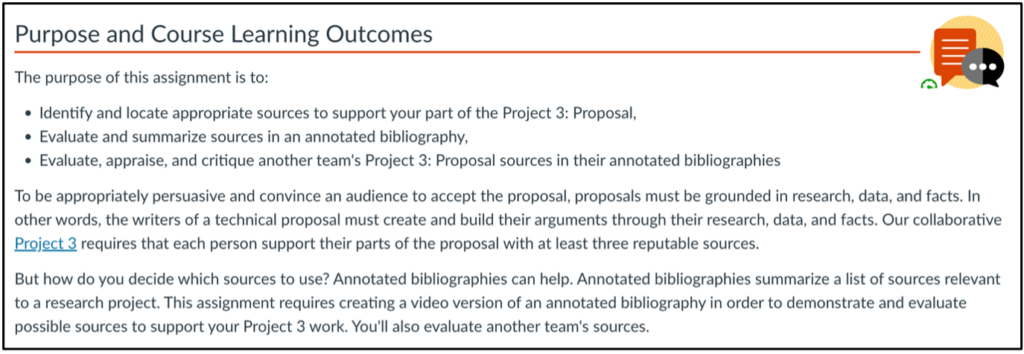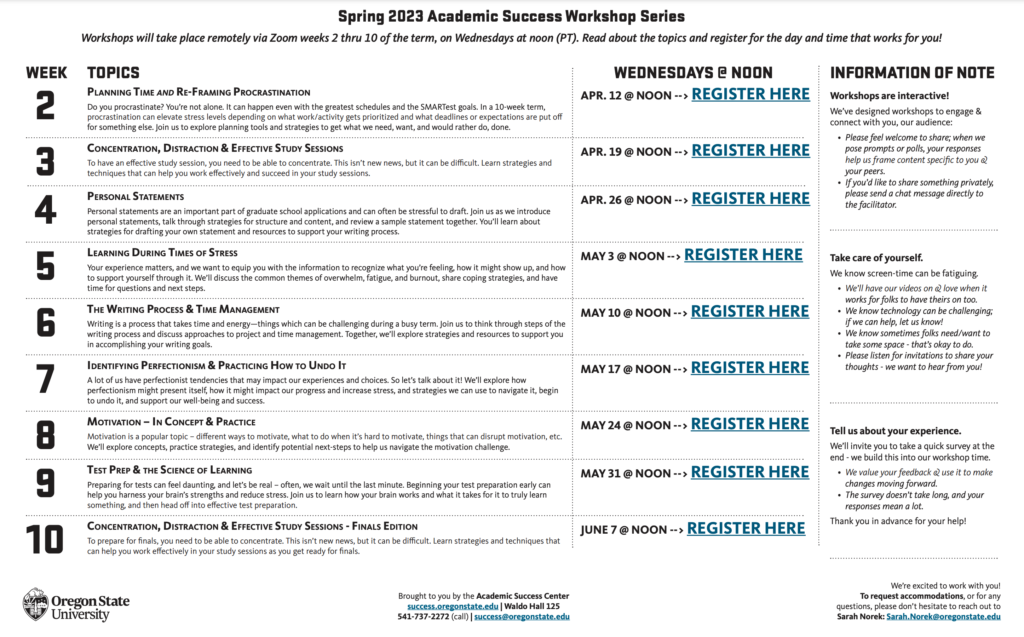“Belonging is a universal human need that is fundamentally linked to learning and well-being. It describes an individual’s experience of feeling that they are, or are likely to be, accepted and respected as a valued contributor in a specific environment.”
Structures for Belonging: A Synthesis of Research on Belonging-Supportive Learning Environments

Maslow’s Hierarchy of Needs is a helpful framework when discussing belonging, which falls in the middle, at level three, just above the basics for survival (level one: air, water, food, shelter) and safety (level 2: health, employment, family, security).
Image from Wikimedia Commons
Have you heard the word belonging recently in reference to students and employees? At OSU, it seems to be popping up frequently in conversations and discussions, onboardings and trainings, online and off, becoming a buzzword for those concerned with teaching and learning, recruitment and outreach, employee satisfaction, and student success, and has become a focal point of our ongoing efforts towards diversity, equity, and inclusion. This increased focus on the concept of belonging at OSU is reflected in the university’s 2018 Innovate & Integrate: Plan for Inclusive Excellence, and is echoed by the 2021 Oregon Department of Education’s passing of the Every Student Belongs rule, which states, “It is the policy of the State Board of Education that all students, employees, and visitors in public schools are entitled to learn, work, and participate in an environment that is safe and free from discrimination, harassment, and intimidation.” These initiatives reflect a growing understanding that traditionally prevailing systems of power have historically marginalized certain groups and excluded them from many realms of life, including education, and prioritize a commitment to changing the status quo explicitly and with intention.
At Ecampus, belonging is an area of active study, and our effort to extend the feeling of belonging to our online students is an important part of our mission, vision, & values and our own Inclusive Excellence Strategic Plan’s goals. We realize that our Ecampus students come from a wide range of backgrounds, seek online learning for a variety of reasons, and comprise higher numbers of students from historically marginalized backgrounds, and thus, combined with the nature of online learning, can feel increased isolation and less of a sense of belonging than their on-campus peers.
What is belonging and why is it important?
Belonging is a complex, multi-layered, and changeable quality that is nonetheless very important for student success. Maslow’s Hierarchy of Needs places belonging in the category of psychological needs, just above the basic needs including food, water, air, safety, and shelter. While there are many definitions, the concept of belonging generally encompasses feeling safe, appreciated, welcomed, valued, and respected in a given situation. Humans learn to search for and interpret signals that they belong or do not belong when entering into new situations or contexts. Marginalized groups have had to learn to be cognizant of where and when they could expect to be excluded and on the alert for cues signaling such. Traditionally, educational institutions have been places of exclusionary practices, often closed to large groups in both policy and practice. Students from marginalized populations, facing this problematic history of exclusion, may be looking for signals and signs that indicate the extent to which they are valued and respected as members of the school community. Students may not be sure they will be accepted in institutions, departments, courses, and other school environments and may be consciously or unconsciously searching for such clues as reassurance that they do, in fact, belong.
Belonging is important for student success because it conveys a host of positive benefits and is a crucial aspect of educational accomplishment. When students find welcoming, inclusive attitudes, see others like themselves being accepted and thriving, and are made to feel safe, protected, supported, and valued, their sense of belonging increases, which in turn allows them to relax and be confident sharing more of their full selves. Students who have a strong sense of belonging show increased academic performance, better attendance, persistence, retention, and motivation, and less likelihood of dropping out. Dr. Terrill Strayhorn, Professor of Urban Education and Vice President for Academic and Student Affairs at LeMoyne-Owen College, in his book College Student’s Sense of Belonging, concludes that “deprivation of belonging in college prevents achievement and wellbeing, while satisfaction of college students’ sense of belonging is a key to educational success for all students.”
In education, as in our society at large, belonging is often related to larger systems that privilege and prefer certain groups and their ideas, beliefs, and ways of being. Those whose race, ethnicity, sexual identity, gender, class, indigeneity, language, or ability are not of the majority are especially likely to be anxious and “on alert” to othering, exclusion, bullying, and stereotyping. This can have dramatic negative short and long term effects, including lowered cognitive capacity, increased stress, and reduced persistence and achievement. Students who lack a sense of belonging may feel uncomfortable in class or group work, unable to concentrate, and may experience self-consciousness and worry, which makes it that much more difficult to attain higher-level needs such as self-confidence, recognition, respect, fulfillment, and achievement. When students face active discrimination, bullying, or other forms of harassment, they may become depressed, choose to disengage, drop courses, or discontinue studying. With such dire consequences, taking the time to understand and assist in ensuring all OSU students are made to feel welcomed and accepted is well worth the effort.
Why do online students sometimes feel less of a sense of belonging?
There are many contributing factors to the disparity between online and traditional students’ development of a sense of belonging, starting with the very nature of the modality in which they study. Students living and studying on campus often have more frequent contact with instructors, campus staff, and other students, both structured and impromptu, providing opportunities to build relationships that can enhance their sense of community and belonging. The pacing of on-campus courses tends to be predictable, with regular meetings during which students often have the chance to ask questions (and receive answers quickly) and get to know fellow students and instructors. Instructors have dedicated class time to review important concepts, check understanding, and provide opportunities for students to get to know them and their fellow students. The traditional on-campus experience is geared towards taking a diverse group of students and building a cohesive community in many ways- students have a wide array of support services available to them, many activities, sports, and clubs they can join, and have a host of opportunities to participate in the rich culture of OSU and in academic and social communities, most of which are easily accessible on campus. Indeed, the very nature of on-campus learning seeks to provide a community for traditional students, many of whom are young and leaving their own homes and communities for the first time.
In contrast, Ecampus courses are asynchronous, featuring no scheduled meeting times, as our students live around the USA and the world. While this format allows for increased access for students who cannot attend in person, the lack of face-to-face interaction can make it difficult for both students and instructors to make personal connections. Unless their courses are carefully designed to provide chances for interaction, conversation, collaboration, and community building, online students may not often interact with their instructors or peers. Online students can experience feelings of isolation, loneliness, and disengagement, which can greatly affect their sense of belonging as an OSU student as well as their success and performance.
Complicating things even further is the tendency to experience digital miscommunication, the concept that humans are less able to infer tone, underlying sentiment, and in general not understand nuance when communicating by text and online, to some extent due to the lack of context and/or visual clues one gets when interacting face to face. A 2016 literature review on the topic of establishing community in online courses found digital communication to be a consistent issue, noting “…the absence of visual meaning-making cues such as gesture, voice tone, and immediate interaction can frustrate students and lead to feelings of isolation and disconnectedness in an online classroom” and recommended that instructors who teach online learn the nuances of these different communication needs.
It must be noted that some online students, who may be older, working full or part time, caring for family, or otherwise already leading (sometimes overly) full lives do not particularly want or need the sense of community that younger traditional students may seek out from their university. They may have little time to devote to community building and little interest in superfluous interaction, shying away from an increased social burden they may not have time and energy to fully commit to. Since we cannot know in advance the detailed makeup of our student body, planning with an assumption that creating belonging is an important aspect of our approach serves online students best.
Stay tuned for Part 2: What can we do to help? for research-based strategies you can use to improve belonging and inclusion.
Sources
Ally for Canvas | Learn@OregonState
Belonging and Emotional Safety – Casel Schoolguide
Building Inclusivity and Belonging | Division of Student Affairs
College Student’s Sense of Belonging
Creating a Safe and Respectful Environment in Our Nation’s Classrooms
Cultural Centers | Oregon State University
Decades of Scientific Research that Started a Growth Mindset Revolution
Establishing Community in Online Courses: A Literature Review
Innovate & Integrate: Plan for Inclusive Excellence | Institutional Diversity
Mission, Vision and Values | Oregon State Ecampus | OSU Degrees Online
Oregon Department of Education
Peer Mentor Program | TRiO | Oregon State University
Social Justice Education Initiative
State of Oregon Diversity, Equity, and Inclusion Action Plan
Student Academic Experience Survey 2022
Utilizing Inclusive and Affirming Language | Institutional Diversity













